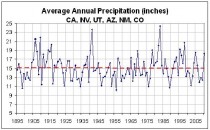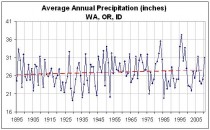By Norman Rogers, Heartland Institute
“Global warming, now called climate change, is a big industry with academic and commercial branches. One way or another the government provides the money to keep it in business. The academic side supports thousands of scientific workers churning out some good science larded with lots of junk science. The commercial side is busy turning out tank cars filled with corn ethanol and covering the landscape with windmills. Nobody would be doing any of this without government subsidies and mandates.”
“One financially minor, but intellectually important, part of the industry is the writing of alarming reports detailing the global warming catastrophe that awaits us if we don’t support the industry. This is the marketing or propaganda side of the climate change industry. A constant drumbeat of propaganda is needed to generate support for the high cost borne by the rest of society to finance the industry. There are many of these alarming studies. The Intergovernmental Panel on Climate Change (IPCC) generates the most prominent alarmist tract. The World Bank has a report. The National Academies of Sciences has a report. The British government did the well-publicized Stern Report. Even the state of California gets into the act, albeit with more amateurish[ii] reports.”
USGCRP stands for the U.S. Global Change Research Program. In spite of the name the USGCRP does not directly do any research. It writes reports. The research is done by numerous programs spread about federal government entities. The USGCRP is hard at work on its periodic national climate assessment. In the jargon of bureaucratic action, numerous conferences, workshops and inputs from stakeholders are driving this supposedly accountable and transparent project.
“The report writers are well informed concerning the requirements of political correctness. They consider tribal (and Alaska native) interests as well as considerations of environmental justice. A federal advisory committee has been formed with more than 40 outside experts and representatives from various federal agencies. Supposedly this advisory committee will write the report and ensure its scientific validity. But a committee of 40 unpaid academics is unlikely to accomplish anything beyond a lot of talk.
The staff will write the report and the purpose of the committee is to bless it and lend credibility. It’s a status exchange. The unpaid academics get to add membership in the federal advisory committee to their resumes and the schemers in the bureaucracy get scientific credibility for their ideological promotions. The wizard behind the scenes is John Holdren, the presidentís science advisor, radical environmentalist and one of the most talented science politicians of our time.”
For more on how the science from these committees is controlled read ”Controlling the Science: National Academies and Consensus” from SPPI.
For more about the money behind the climate change industry, read ”A Nest of Carbon Vipers”, and High Level Climate Finance - The Key to Global Governance, both also from SPPI.
By Joanne Nova
The PR machine has spent twenty years pretending to be scientific while they push poll the phrase “carbon is pollution” (Don’t you want to stop pollution?) But turn the polling inside out and the nonsense is exposed. Stephen Harper takes the PR team’s theme to its logical conclusion and uses it against them.
Forget plate tectonics and continental drift. A trace gas in the atmosphere can reshape the Earth, at least, that’s apparently how many people see it. A new survey shows that over a third of the population think that climate change induces not just tsunamis, but even volcanic eruptions. Worse, 37% of people are so convinced carbon is pollution that they think it would be a worthwhile aim to reduce the carbon content of their body. (The ultimate diet, you might say).
About a quarter of the population are so plum-confused about what carbon is, they would rather not eat food with carbon in it. (Crikey!) The numbers taken in by the mass delusion are shocking. Nearly half the population think food would be safer without carbon.
This is the unscientific bias of our national bureaucracies, institutions, and science communicators laid bare.
Stephen Harper randomly questioned 100 people with one the most original, useful surveys I’ve seen yet. Even though the numbers are small, his questions give us real insight into just how successful our various science journalists, science communicators and government public relations departments are at getting across the basics. After all, Tim Flannery, CSIRO, and the Department of Education want to make sure people understand “the science” don’t they?
Indeed, believers of the Theory of Man-Made Catastrophe often blame their poor communication skills for the rising tide of skepticism. Au Contraire, I say. They’ve done a masterful job of conveying the public relations message “carbon is pollution” and have been extraordinarily successful at hiding the basic facts of life like: we are carbon life forms, and literally everything edible in your kitchen was made with CO2 (bar salt, water and industrial food additives).
The carbon in meat, milk and salad came from the sky. Did they forget to mention that? I can’t think why.
Don’t misread this, it’s not about how clever the public is or isn’t, it’s about how well “the science” has been conveyed. All the glossy brochures, school handouts, 3,000 page reports, press releases, endless repetition of “carbon pollution” by politicians and journalists, and coloring in competitions have been effective propaganda. The Ministry of Disinformation has been hard at work.
Thanks to Stephen Harper for this original, insightful contribution. It must have taken weeks to compile. The questions and results are documented in this PDF. The survey covered a broad cross section of ages and voting types, and Stephen plans to keep surveying to increase the size of the survey.
- Jo
---------
THE PUBLIC FAILS THE KNOWLEDGE TEST ON CARBON IS MEDIA POLLUTION THE CAUSE?
Guest Post By Stephen L. Harper, April 29th 2011
A survey just conducted in the streets of Perth, Australia shows a disturbing lack of basic understanding of the roles carbon and carbon dioxide play in life processes on planet earth. It also highlights some monumental elementary misapprehensions regarding climate change issues.
A staggering 37% of carbon-based-life-form respondents are keen on reducing carbon in the human body. Perhaps the amputation of an appendage at the end of the leg will be the new way to reduce one’s carbon footprint.
Equally remarkable is the finding that 44% of respondents wish to eliminate carbon and carbon dioxide from food and drink altogether. Nonplussed are the 28% of respondents who don’t think there is any carbon or carbon dioxide in food and drink in the first place.
Another alarming finding is that 47% of respondents think carbon dioxide is a pollutant. Marginally less at 44% give poor old carbon, the sixth element of the periodic table (and my personal favourite, since without it we would not exist), the big thumbs down.
A solid majority of 77% know that carbon dioxide is invisible which is encouraging. Yet, there are still many labouring under the misconception that carbon dioxide is black, grey or white - and in some fanciful imaginings, green, blue, yellow or even purple. Thankfully no polka dots.
Knowing CO2’s colour is one thing but knowing its concentration in the atmosphere is quite another.
CO2 comprises less than 1/20th of one percent of the earth’s atmosphere - it is a trace gas. Just 7% of respondents knew that CO2’s concentration was under 1%; a sizeable 44% saying more than 10% concentration and 21% saying CO2 represents more than 50% of the atmosphere - an asphyxiating notion if ever there was one. So it would seem the alarmist media has done a sterling job in creating the perception that CO2 is the dominant player in the earth’s atmosphere.
One fifth of the population estimates CO2 is 1000 times higher than it is.
These days we hear that climate change is the animating agent for many things, but it will be news to vulcanologists, seismologists and oceanographers that climate change causes tsunamis, earthquakes and volcanic eruptions. Or so say a disturbingly high percentage of respondents to the survey at 53%, 40% and 37%, respectively.
Younger people (18-25) were easily the group most bent upon ascribing causation of these natural events to climate change. For starters, a whopping 82% cast climate change as the villain most likely when unwelcome tsunamis visit our shores. In the same vein 76% of this group think a small increase in a trace gas (CO2), trumps tectonic plate movement and complex processes in the earth’s crust as the causative agent for earthquakes and volcanic eruptions.
People wildly overestimated the power of the Australian government to control planetary warming.
When asked what difference a 5% reduction in Australia’s greenhouse gas emissions by 2020 would make to global warming more than a third imagined a forestalling of more than one degree of warming and 14% predicted a staving off of more than 2 degrees of warming. These are staggering over-estimates.
If we accept the IPCC’s worst-case scenario (the IPCC being the UN’s purported gold standard of climate science) of 4.5 degrees warming by 2100 (and this itself is a huge over-estimate), pro rata this to 0.5 degrees by 2020, multiply this by Australia’s 1.4% of global emissions and multiply that answer by 5% (the proposed emissions reduction) we get 0.00035 degrees of warming forestalled. And if we consider that the 5% reduction would happen in a step-wise manner over a ten year period, the actual quantum of greenhouse gas emissions reduced by 2020 is just 2.5%. So the warming prevented is 0.000175 degrees - an unmeasurable amount that is essentially zero. Now that’s “action on climate change” you can believe in. Or not.
When asked what percentage of climate change is human-induced versus natural, the average of respondents’ answers was a 55%/45% split. Respondents were also equally divided (48%/51%/1% - yes/no/donít know) on the question of support for the federal Labor government’s “gift to the nation” of a carbon tax (which PM Julia Gillard expressly ruled out prior to the October 2010 federal election). Coalition voters were the least supportive at 25%, with Labor voters at 60% and Greens voters an enthusiastic 64% happy to submit. Greens voters were also the most eager to contribute financially offering up an average $1,142 a year sacrifice to the carbon reduction god.
This survey did not test the knowledge the general public has of climate science itself. It examined perceptions of climate change and the public’s understanding of basic scientific concepts concerning carbon dioxide in the atmosphere and carbon (and CO2) in living things and in food. The responses are troubling to say the least. The public’s knowledge in these areas is very poor and in some cases some beliefs are downright alarming.
Of course, not everyone’s understanding is dismal and compromised. Many people know enough to shield themselves from the depredations of blatant scare-mongering. In particular, independent voters acquitted themselves very well, proving consistently to be the most well informed of all groups (whether classified by age or political preference). Nevertheless, all is not well regarding the public’s comprehension of these issues.
What do we make of the results of this survey?
Why is public knowledge of basic scientific facts so poor? No doubt people’s general educational levels play a part, but many of the perceptions are so fanciful that they could not have come from a misremembered science class. No, it is most likely the media who are responsible, creating a huge bogey out of carbon dioxide and carbon in the minds of the public with their incessant and indiscriminate alarmism regarding global warming/climate change. If the public has been so comprehensively duped what hope is there for rational discussion of the issue formerly known as “the great moral and economic challenge of our time”?
Post is here.
Climate change is likely to diminish already scarce water supplies in the Western United States, exacerbating problems for millions of water users in the West, according to a new government report.
A report released Monday by the Interior Department said annual flows in three prominent river basins - the Colorado, Rio Grande and San Joaquin - could decline by as much 8 percent to 14 percent over the next four decades. The three rivers provide water to eight states, from Wyoming to Texas and California, as well as to parts of Mexico.
The declining water supply comes as the West and Southwest, already among the fastest-growing parts of the country, continue to gain population.
Interior Secretary Ken Salazar called water the region’s “lifeblood” and said small changes in snowpack and rainfall levels could have a major effect on tens of millions of people.
The report will help officials understand the long-term effects of climate change on Western water supplies, Salazar said, and will be the foundation for efforts to develop strategies for sustainable water resource management.
The report notes that projected changes in temperature and precipitation are likely to alter the timing and quantity of stream flows in all Western river basins, with increased flooding possible in the winter due to early snowmelt and water shortages in the summer due to reductions in spring and summer runoffs. Changes in climate could affect water supplies to a range of users, from farms and cities to hydropower plants, fish, wildlife and recreation, the report said.
Western states are growing faster than the rest of the country, with some of the fastest growth occurring in the driest areas, such as Nevada, Arizona and Texas.
“Impacts to water are on the leading edge of global climate change,” said Mike Connor, commissioner of the Bureau of Reclamation, an Interior Department agency that provides water to more than 31 million people in 17 Western states and power to 3.5 million homes.
The report “affirms the urgency of the planning we are engaged in,” Connor said at a news conference Monday. “We need to take actions now to plan” for changes that are likely to occur over the next several decades.
The report addresses the expected impact of climate change on eight major rivers basins in the central and Western United States. Besides the Colorado, Rio Grande and San Joaquin, the report also looks at the Columbia, Klamath and Sacramento rivers on the West Coast; the Missouri River Basin in the Northwest and Great Plains; and the Truckee River Basin in California and Nevada.
All eight basins should see an increase in temperature of about 5 to 7 degrees Fahrenheit by the end of the century, the report says. Four basins will see an increase in overall precipitation by 2050: the Upper Colorado, Columbia, Missouri and Sacramento, while four will see a decrease: the Lower Colorado, Rio Grande, San Joaquin and Truckee.
Reductions in spring and summer runoffs could lead to a drop in water supply in 6 of the 8 basins, the report said.
Due to early snowmelt and relatively higher winter rains from warmer conditions, all but the Colorado basin could become more vulnerable to floods, the report said.
Aiguo Dai, a climate scientist with the National Center for Atmospheric Research in Boulder, Colo., said the report echoes predictions he and other researchers have made that climate change would reduce stream flow rates in Western U.S. rivers. But he said computer models used to assess global trends would not be helpful for small river basins such as the Klamath or Upper Rio Grande.
Even regional models that take local topography into account “still contain large uncertainties,” Dai said.
Sen. Jeff Bingaman, D-N.M., said the report did “a solid job” cataloguing Interior’s efforts to respond to climate change. Bingaman, chairman of the Senate Energy and Natural Resources Committee, sponsored a 2009 law that aims to improve water management in the West and increase analysis of water-related data. The report released Monday was prepared in response to the Secure Water Act.
“Faced with forecasts of decreased stream flows and increased temperatures, it’s more important than ever for communities to actively plan for changing conditions,” Bingaman said. “In arid environments like New Mexico, every drop counts, and conservation and efficient water use are essential. Having tools available to accurately monitor existing water supplies, and to accurately predict future scenarios, can provide more certainty to water users and help decrease tensions.”
Icecap Reality Check: Lets look instead of at models at the actual precipitation an an annual basis for the southwest including California, Nevada, Utah, New Mexico, Arizona and Colorado and the Pacific Northwest - Washington, Oregon and Idaho. Note the southwest plot since 1895 has no, nil nada trend and the Pacific Northwest is cyclical with a net upward trend.
Whatsmore CO2 enhances plant growth and reduces water need because the CO2 enriched plants are more drought resistant. So Secy Salazar, a part of what is likely the most scientifically inept and/or corrupt and ideologically driven adminstrations in history is wrong on two major counts. Note how the media dutifully plays along with the administration they helped elect.
A scientist who sent me the story sent me this note:
This is a revealing graph! I have not seen the DOI report, but my guess is that all their emphasis is most likely on ‘future climate’ as predicted by models with little attention being paid to observed climate trends.... There is a really strong bias in government agencies towards a ‘CO2-driven future climate’ to the point that the term ‘climate change’ is almost entirely associated in the minds of managers with ‘model predictions’ and ‘emission scenarios’. Recently, I wanted to make a presentation at the Forest Service about observed climate and I had to clarify several times to the leadership of the Rocky Mountain Station that I’m talking about trends in actual measured data, not model simulations. At the end, when they realized that I was going to discuss (among other things) the lack of warming over the past 10-12 years, they canceled my talk with the argument that I’m not a ‘climate scientist’ and therefore do not have the necessary expertise, and that FS has made a large investment in adapting to GCM-predicted climate change. This is the crux of the problem. What an entangled web they weave.




